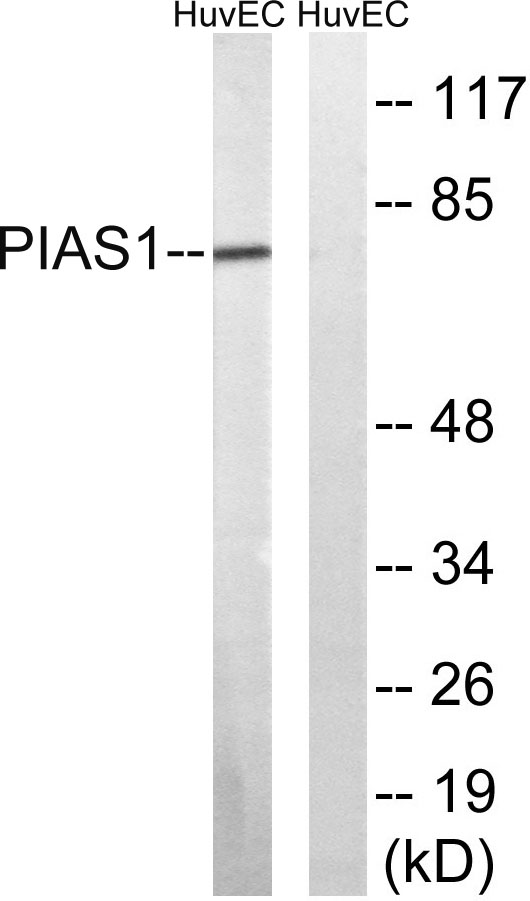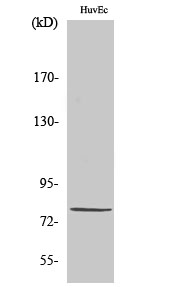产品名称
PIAS 1 Rabbit Polyclonal Antibody
别名
PIAS1; DDXBP1; E3 SUMO-protein ligase PIAS1; DEAD/H box-binding protein 1; Gu-binding protein; GBP; Protein inhibitor of activated STAT protein 1; RNA helicase II-binding protein
蛋白名称
E3 SUMO-protein ligase PIAS1
存储缓冲液
Liquid in PBS containing 50% glycerol, 0.5% BSA and 0.02% New type preservative N.
Human Gene Link
http://www.ncbi.nlm.nih.gov/sites/entrez?db=gene&term=8554
Human Swissprot No.
O75925
Human Swissprot Link
http://www.uniprot.org/uniprotkb/O75925/entry
Mouse Gene Link
http://www.ncbi.nlm.nih.gov/sites/entrez?db=gene&term=56469
Mouse Swissprot No.
O88907
Mouse Swissprot Link
http://www.uniprot.org/uniprot/O88907
免疫原
The antiserum was produced against synthesized peptide derived from human PIAS1. AA range:10-59
特异性
PIAS 1 Polyclonal Antibody detects endogenous levels of PIAS 1 protein.
稀释度
WB 1:500 - 1:2000. IHC 1:100 - 1:300. ELISA: 1:10000.. IF 1:50-200
宿主
Polyclonal, Rabbit,IgG
背景介绍
This gene encodes a member of the protein inhibitor of activated STAT (PIAS) family. PIAS proteins function as SUMO E3 ligases and play important roles in many cellular processes by mediating the sumoylation of target proteins. This protein plays a central role as a transcriptional coregulator of numerous cellular pathways includign the STAT1 and nuclear factor kappaB pathways. Alternate splicing results in multiple transcript variants. [provided by RefSeq, Mar 2016],
组织表达
Expressed in numerous tissues with highest level in testis.
细胞定位
Nucleus speckle . Nucleus, PML body . Interaction with CSRP2 may induce a partial redistribution along the cytoskeleton.
信号通路
Ubiquitin mediated proteolysis;Jak_STAT;Pathways in cancer;Small cell lung cancer;
功能
domain:The LXXLL motif is a transcriptional coregulator signature.,domain:The SP-RING-type domain is required for promoting EKLF sumoylation.,function:Functions as an E3-type small ubiquitin-like modifier (SUMO) ligase, stabilizing the interaction between UBE2I and the substrate, and as a SUMO-tethering factor. Plays a crucial role as a transcriptional coregulation in various cellular pathways, including the STAT pathway, the p53 pathway and the steroid hormone signaling pathway. The effects of this transcriptional coregulation, transactivation or silencing, may vary depending upon the biological context.,pathway:Protein modification; protein sumoylation.,PTM:Sumoylated.,similarity:Belongs to the PIAS family.,similarity:Contains 1 SAP domain.,similarity:Contains 1 SP-RING-type zinc finger.,subcellular location:Interaction with CSRP2 may induce a partial redistribution along the cytoskeleton.,subunit:Binds SUMO1 and UBE2I. Interacts with AR, CSRP2, JUN, MDM2, NCOA2, TP53, RNA helicase II and STAT1 dimers, following IFN-alpha-stimulation. Interacts with SP3, preferentially when SUMO-modified. Binds preferentially AT-rich DNA sequences, known as matrix or scaffold attachment regions (MARs/SARs) (By similarity). Interacts with PLAG1. Interacts with KLF8; the interaction results in SUMO ligation and repression of KLF8 transcriptional activity and of its cell cycle progression into G(1) phase.,tissue specificity:Expressed in numerous tissues with highest level in testis.,
纯化
The antibody was affinity-purified from rabbit antiserum by affinity-chromatography using epitope-specific immunogen.



